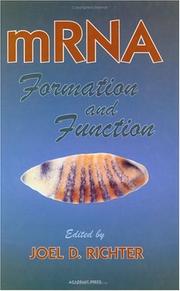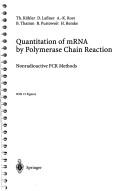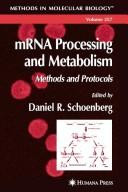| Listing 1 - 10 of 14 | << page >> |
Sort by
|
Book
ISBN: 9789493296008 Year: 2023 Publisher: Nijmegen : Radboud University Press,
Abstract | Keywords | Export | Availability | Bookmark
 Loading...
Loading...Choose an application
- Reference Manager
- EndNote
- RefWorks (Direct export to RefWorks)
On 20 October 2022, the day that Radboud University celebrated its 99th anniversary, Dr. Katalin Karikó received a Radboud honorary doctorate in recognition of her scientific contributions to developing mRNA-based vaccines. This edition includes the laudatio of the honorary supervisor and the speech of the honorary doctor.Karikó spent years researching medical applications of mRNA. Her dream was to develop synthetic mRNA and use this to cure cancer, strokes, and influenza. Eventually, after years of toil, rejection, and criticism from colleagues, she and fellow researcher Drew Weissman demonstrated that it is possible to trigger an immune response in the body with mRNA without the body turning against the mRNA itself. With this breakthrough, a new revolutionary technique was born.Thanks to Karikó's scientific work, BioNTech/Pfizer and Moderna were able to develop the current mRNA vaccines against COVID-19. A prime example of the beneficial impact that fundamental research can eventually have on society. Honorary supervisor Floris Rutjes, Professor in Organic Synthesis: "With courage and determination, she pursued her scientific vision for a very long time, and by doing so, she has ultimately made a significant contribution to the fight against viral diseases."
Messenger RNA. --- mRNA vaccines. --- Messenger RNA vaccines --- Naked RNA vaccines --- RNA vaccines --- Synthetic vaccines --- Informational RNA --- Messenger ribonucleic acid --- mRNA --- Protein transcript --- Protein transcripts --- Template RNA --- RNA --- Karikó, Katalin. --- Karikó, Kati
Book
ISBN: 1281397636 9786611397630 3540767762 3540767754 3642095445 Year: 2008 Publisher: Berlin : Springer,
Abstract | Keywords | Export | Availability | Bookmark
 Loading...
Loading...Choose an application
- Reference Manager
- EndNote
- RefWorks (Direct export to RefWorks)
In recent years nuclear pre-mRNA processing has taken center stage as an important regulator of gene expression and ultimately growth and development. Large-scale genome and cDNA sequencing projects together with bioinformatic analyses of these sequences have revealed that alternative splicing of pre-mRNAs contributes greatly to transcriptome and proteome complexity in eukaryotes. During the last few years, tremendous progress has been made in understanding various aspects of pre-mRNA processing including alternative splicing and its importance in plant growth and development as well as in plant responses to hormones and stresses. This book, with contributions from leading scientists in this area, summarizes recent advances in nuclear pre-mRNA processing in plants. It provides researchers in the field, as well as those in related areas, with an up-to-date and comprehensive, yet concise, overview of the current status and future potential of this research in understanding plant biology.
Plant genetic regulation. --- Plant gene expression. --- Messenger RNA. --- RNA splicing. --- Messenger RNA splicing --- Splicing, RNA --- Genetic regulation --- Informational RNA --- Messenger ribonucleic acid --- mRNA --- Protein transcript --- Protein transcripts --- Template RNA --- RNA --- Gene expression --- Plant molecular genetics --- Plant gene expression --- Plant cellular control mechanisms --- Regulation --- Botany. --- Plant Sciences. --- Botanical science --- Phytobiology --- Phytography --- Phytology --- Plant biology --- Plant science --- Biology --- Natural history --- Plants --- Plant science. --- Floristic botany
Book
ISSN: 00766879 ISBN: 9780123743787 0123743788 9786612287312 1282287311 0080922074 Year: 2008 Volume: 448 Publisher: San Diego, Calif. ; London : Academic,
Abstract | Keywords | Export | Availability | Bookmark
 Loading...
Loading...Choose an application
- Reference Manager
- EndNote
- RefWorks (Direct export to RefWorks)
Specific complexes of protein and RNA carry out many essential biological functions, including RNA processing, RNA turnover, RNA folding, as well as the translation of genetic information from mRNA into protein sequences. Messenger RNA (mRNA) decay is now emerging as an important control point and a major contributor to gene expression. Continuing identification of the protein factors and cofactors, and mRNA instability elements responsible for mRNA decay allow researchers to build a comprehensive picture of the highly orchestrated processes involved in mRNA decay and its regulation.
Messenger RNA. --- Genetic regulation. --- Eukaryotic cells. --- Nucleases. --- ARN messager --- Régulation génétique --- Cellules eucaryotes --- Régulation génétique --- Eucaryotic cells --- Gene expression --- Gene expression regulation --- Gene regulation --- Informational RNA --- Messenger ribonucleic acid --- mRNA --- Protein transcript --- Protein transcripts --- Template RNA --- Regulation --- Esterases --- Cells --- Protista --- Biosynthesis --- Cellular control mechanisms --- Molecular genetics --- RNA

ISBN: 1281119326 9786611119324 0080537049 0125875452 Year: 1997 Publisher: San Diego : Academic Press,
Abstract | Keywords | Export | Availability | Bookmark
 Loading...
Loading...Choose an application
- Reference Manager
- EndNote
- RefWorks (Direct export to RefWorks)
mRNA Formation and Function presents a compendium of techniques geared exclusively toward the understanding of RNA metabolism. It will be particularly useful because a number of different organisms and systems are employed.Key Features* Isolation and characterization of specific RNA binding proteins* RNA metabolism and associated regulatory proteins* RNA detection and localization* A genetic approach to RNA function
Messenger RNA. --- Messenger RNA--Research--Methodology. --- Messenger RNA --- RNA, Messenger --- Research Design --- Research --- RNA --- Methods --- Investigative Techniques --- Science --- Nucleic Acids --- Nucleic Acids, Nucleotides, and Nucleosides --- Natural Science Disciplines --- Analytical, Diagnostic and Therapeutic Techniques and Equipment --- Chemicals and Drugs --- Disciplines and Occupations --- Animal Biochemistry --- Human Anatomy & Physiology --- Health & Biological Sciences --- Methodology --- RNA. --- Methodology. --- Ribonucleic acid --- Ribose nucleic acid --- Informational RNA --- Messenger ribonucleic acid --- mRNA --- Protein transcript --- Protein transcripts --- Template RNA --- Nucleic acids --- Ribose
Article
Abstract | Keywords | Export | Availability | Bookmark
 Loading...
Loading...Choose an application
- Reference Manager
- EndNote
- RefWorks (Direct export to RefWorks)
Oxytocin secretion from the posterior pituitary gland is increased during parturition, stimulated by the uterine contractions that forcefully expel the fetuses. Since oxytocin stimulates further contractions of the uterus, which is exquisitely sensitive to oxytocin at the end of pregnancy, a positive feedback loop is activated. The neural pathway that drives oxytocin neurons via a brainstem relay has been partially characterised, and involves A2 noradrenergic cells in the brainstem. Until close to term the responsiveness of oxytocin neurons is restrained by neuroactive steroid metabolites of progesterone that potentiate GABA inhibitory mechanisms. As parturition approaches, and this inhibition fades as progesterone secretion collapses, a central opioid inhibitory mechanism is activated that restrains the excitation of oxytocin cells by brainstem inputs. This opioid restraint is the predominant damper of oxytocin cells before and during parturition, limiting stimulation by extraneous stimuli, and perhaps facilitating optimal spacing of births and economical use of the store of oxytocin accumulated during pregnancy. During parturition, oxytocin cells increase their basal activity, and hence oxytocin secretion increases. In addition, the oxytocin cells discharge a burst of action potentials as each fetus passes through the birth canal. Each burst causes the secretion of a pulse of oxytocin, which sharply increases uterine tone; these bursts depend upon auto-stimulation by oxytocin released from the dendrites of the magnocellular neurons in the supraoptic and paraventricular nuclei. With the exception of the opioid mechanism that emerges to restrain oxytocin cell responsiveness, the behavior of oxytocin cells and their inputs in pregnancy and parturition is explicable from the effects of hormones of pregnancy (relaxin, estrogen, progesterone) on pre-existing mechanisms, leading through relative quiescence at term inter alia to net increase in oxytocin storage, and re
Activation. --- Activity. --- Adaptation. --- Allopregnanolone. --- Behavior. --- Birth. --- Brainstem. --- C-fos expression. --- Dendrites. --- Dynorphin. --- Enkephalin. --- Estrogen receptors. --- Estrogen. --- Feedback. --- Fetuses. --- Firing. --- Gaba. --- Gamma-aminobutyric-acid. --- Gland. --- Hormone. --- Hormones. --- Hypothalamic paraventricular nucleus. --- Increase. --- Increases. --- Inhibition. --- Main olfactory-bulb. --- Mechanisms. --- Messenger-ribonucleic-acid. --- Milk-ejection reflex. --- Neurons in-vitro. --- Neurons. --- Nitric oxide synthase. --- Nitric-oxide synthase. --- Nucleus tractus solitarius. --- Opioid. --- Oxytocin mrna. --- Oxytocin. --- Parturition. --- Pattern. --- Patterns. --- Pituitary. --- Potentials. --- Pregnancy. --- Progesterone-receptor expression. --- Progesterone. --- Rat supraoptic nucleus. --- Response. --- Restraint. --- Review. --- Secretion. --- Steroid metabolites. --- Steroid. --- Stimulation. --- Stimuli. --- Supraoptic nucleus. --- System. --- Time. --- Uterus.
Book
ISSN: 01712004 ISBN: 1280462094 9786610462094 3540272623 Year: 2006 Volume: v. 173 Publisher: Berlin : Springer,
Abstract | Keywords | Export | Availability | Bookmark
 Loading...
Loading...Choose an application
- Reference Manager
- EndNote
- RefWorks (Direct export to RefWorks)
Developments over the past few years have revealed the remarkable versatility of RNA in any compartment of the cell, tasks that had been thought to be exclusively in the realm of proteins and even beyond. The chapters in this book written by leading investigators in the field provide insight into various promising avenues where RNA and nucleic acid derivatives including antisense RNAs, such as siRNA, miRNAs, amplification/selection (SELEX) generated aptamers as well as ribozymes are at the threshold of impacting medicine.
RNA. --- Messenger RNA. --- Informational RNA --- Messenger ribonucleic acid --- mRNA --- Protein transcript --- Protein transcripts --- Template RNA --- RNA --- Ribonucleic acid --- Ribose nucleic acid --- Nucleic acids --- Ribose --- Biochemistry. --- Toxicology. --- Medicine. --- Biochemistry, general. --- Pharmacology/Toxicology. --- Molecular Medicine. --- Medicine/Public Health, general. --- Clinical sciences --- Medical profession --- Human biology --- Life sciences --- Medical sciences --- Pathology --- Physicians --- Chemicals --- Medicine --- Pharmacology --- Poisoning --- Poisons --- Biological chemistry --- Chemical composition of organisms --- Organisms --- Physiological chemistry --- Biology --- Chemistry --- Toxicology --- Composition --- Health Workforce --- Pharmacology. --- Molecular biology. --- Molecular biochemistry --- Molecular biophysics --- Biochemistry --- Biophysics --- Biomolecules --- Systems biology --- Drug effects --- Medical pharmacology --- Chemotherapy --- Drugs --- Pharmacy --- Physiological effect --- Medical sciences. --- Biomedical Research. --- Health Sciences. --- Research. --- Basic medical sciences --- Basic sciences, Medical --- Biomedical sciences --- Health sciences --- Preclinical sciences --- Sciences, Medical --- Biological research --- Biomedical research

ISBN: 3540591923 3642797148 3642797121 9783540591924 Year: 1995 Publisher: Berlin Springer
Abstract | Keywords | Export | Availability | Bookmark
 Loading...
Loading...Choose an application
- Reference Manager
- EndNote
- RefWorks (Direct export to RefWorks)
Molecular biology --- Polymerase chain reaction --- Messenger RNA --- Laboratory manuals --- Analysis --- Acide nucléique --- Nucleic acids --- Analyse quantitative --- Quantitative analysis --- PCR --- Diagnostic de laboratoire --- Laboratory diagnosis --- Électrophorèse --- Electrophoresis --- ADN --- DNA --- ARN --- RNA --- Génie génétique --- genetic engineering --- Biologie moléculaire --- Technique immunoenzymatique --- Immunoenzyme techniques --- -Polymerase chain reaction --- -57.08 --- 577.21 --- DNA deoxyribonucleic acid --- ELISA enzyme linked immunosorbent assays --- HPLC high performance liquid chromatography --- PCR polymerase chain reaction --- RNA ribonucleic acid --- analytische biochemie --- biochemie --- biologie --- kwantitatieve pcr --- laboratoriumbiologie --- laboratoriumhandboeken --- mRNA --- moleculaire biologie --- nucleïnezuren --- Chain reaction, Polymerase --- PCR (Biochemistry) --- Polymerization --- DNA polymerases --- Informational RNA --- Messenger ribonucleic acid --- Protein transcript --- Protein transcripts --- Template RNA --- -Laboratory manuals --- biologische technieken, experimentele methoden en uitrusting in het algemeen --- Laboratory manuals. --- DNA. --- RNA. --- 57.08 --- Analysis&delete& --- Polymerase chain reaction - Laboratory manuals --- Messenger RNA - Analysis - Laboratory manuals

ISBN: 1588292258 1592597505 128036047X 9786610360475 Year: 2004 Volume: 257 Publisher: Totowa Humana press
Abstract | Keywords | Export | Availability | Bookmark
 Loading...
Loading...Choose an application
- Reference Manager
- EndNote
- RefWorks (Direct export to RefWorks)
mRNA processing is a key step in gene expression that effects all the proteins within the cell. In mRNA Processing and Metabolism: Methods and Protocols, world-renowned researchers bring together the latest techniques spanning the breadth of mRNA processing and metabolism. Drawing on recent advances in microscopy, whole genome sequencing, microarrays, mass spectrometry, fluorescent detection methodologies, and RNA interference, the authors offer readily reproducible methods for the cotranscriptional processing events that occur while the mRNA is engaged with elongating RNA polymerase II, with splicing and its biochemical analysis and with alternative splicing. Additional methods cover mRNA export, the recovery and analysis of mRNP complexes, cytoplasmic translation, mRNA degradation in vivo and in vitro, and the controversial concept of nuclear translation. A variety of model organisms are used, including yeast, Drosophila, Xenopus, mice, plants, and cultured mammalian cells. Each proven protocol is described in step-by-step detail and contains an introduction outlining the principle behind the technique, lists of equipment and reagents, and tips on troubleshooting and avoiding known pitfalls. Timely and authoritative, mRNA Processing and Metabolism: Methods and Protocols provides a powerful collection of novel techniques that are not only effective, but also immediately applicable to current problems in many areas of biological research.
Messenger RNA --- ARN messager --- Laboratory manuals --- Manuels de laboratoire --- Electronic books. -- local. --- Genetics -- Technique. --- Messenger RNA -- Laboratory manuals. --- RNA, Messenger --- Genetic Techniques --- Metabolism --- Metabolic Phenomena --- RNA --- Investigative Techniques --- Nucleic Acids --- Analytical, Diagnostic and Therapeutic Techniques and Equipment --- Phenomena and Processes --- Nucleic Acids, Nucleotides, and Nucleosides --- Chemicals and Drugs --- Animal Biochemistry --- Human Anatomy & Physiology --- Health & Biological Sciences --- 577.216 --- 57.088.6 --- Transfer of inheritance information. Transport of messenger RNA in the cell --- Methods and techniques for studying metabolism and biotransformation.Radioisotopes methods and techniques. --- 57.088.6 Methods and techniques for studying metabolism and biotransformation.Radioisotopes methods and techniques. --- 577.216 Transfer of inheritance information. Transport of messenger RNA in the cell --- Genetics --- Technique. --- Informational RNA --- Messenger ribonucleic acid --- mRNA --- Protein transcript --- Protein transcripts --- Template RNA --- Methods and techniques for studying metabolism and biotransformation.Radioisotopes methods and techniques --- Cytology. --- Cell Biology. --- Cell biology --- Cellular biology --- Biology --- Cells --- Cytologists
Book
ISSN: 00766879 ISBN: 9780123743770 012374377X 9786612287329 128228732X 0080922066 Year: 2008 Volume: 447 Publisher: Amsterdam ; Boston : Elsevier/Academic Press,
Abstract | Keywords | Export | Availability | Bookmark
 Loading...
Loading...Choose an application
- Reference Manager
- EndNote
- RefWorks (Direct export to RefWorks)
Specific complexes of protein and RNA carry out many essential biological functions, including RNA processing, RNA turnover, RNA folding, as well as the translation of genetic information from mRNA into protein sequences. Messenger RNA (mRNA) decay is now emerging as an important control point and a major contributor to gene expression. Continuing identification of the protein factors and cofactors, and mRNA instability elements, responsible for mRNA decay allow researchers to build a comprehensive picture of the highly orchestrated processes involved in mRNA decay and its regulation.
RNA-protein interactions. --- Messenger RNA. --- Genetic regulation. --- Prokaryotes. --- Cell organelles. --- Interactions ARN-protéines --- ARN messager --- Régulation génétique --- Procaryotes --- Organites cellulaires --- Bacteria. --- Organelles,. --- RNA Stability. --- RNA, Archaeal. --- RNA, Bacterial. --- RNA, Bacterial --- RNA, Archaeal --- Organelles --- mRNA Cleavage and Polyadenylation Factors --- RNA Stability --- RNA --- RNA-Binding Proteins --- Biochemical Phenomena --- Cytoplasmic Structures --- Cytoplasm --- Nucleic Acids --- Nucleoproteins --- Carrier Proteins --- Chemical Phenomena --- Intracellular Space --- Nucleic Acids, Nucleotides, and Nucleosides --- Proteins --- Phenomena and Processes --- Cellular Structures --- Chemicals and Drugs --- Amino Acids, Peptides, and Proteins --- Cells --- Anatomy --- Animal Biochemistry --- Human Anatomy & Physiology --- Health & Biological Sciences --- Interactions ARN-protéines --- Régulation génétique --- Organelles, Cell --- Germs --- Microbes --- Gene expression --- Gene expression regulation --- Gene regulation --- Informational RNA --- Messenger ribonucleic acid --- mRNA --- Protein transcript --- Protein transcripts --- Template RNA --- Interactions, RNA-protein --- Protein-RNA interactions --- RNA-protein binding --- Regulation --- Prokaryotes --- Biosynthesis --- Cellular control mechanisms --- Molecular genetics --- Protein binding
Periodical
Abstract | Keywords | Export | Availability | Bookmark
 Loading...
Loading...Choose an application
- Reference Manager
- EndNote
- RefWorks (Direct export to RefWorks)
RNA, Messenger. --- Translational Medical Research. --- Messenger RNA --- Genetic translation --- Translation (Genetics) --- Informational RNA --- Messenger ribonucleic acid --- mRNA --- Protein transcript --- Protein transcripts --- Template RNA --- Knowledge Translation --- Translational Medical Science --- Translational Medicine --- Translational Research, Medical --- Translational Research --- Knowledge Translations --- Medical Research, Translational --- Medical Science, Translational --- Medical Sciences, Translational --- Medical Translational Research --- Medicine, Translational --- Research, Medical Translational --- Research, Translational --- Research, Translational Medical --- Science, Translational Medical --- Sciences, Translational Medical --- Translation, Knowledge --- Translational Medical Sciences --- Translational Researchs --- Translations, Knowledge --- Non-Polyadenylated mRNA --- Poly(A) RNA --- Polyadenylated mRNA --- Messenger RNA, Polyadenylated --- Poly(A) Tail --- Poly(A)+ RNA --- Poly(A)+ mRNA --- RNA, Messenger, Polyadenylated --- RNA, Polyadenylated --- mRNA, Non-Polyadenylated --- mRNA, Polyadenylated --- Non Polyadenylated mRNA --- Polyadenylated Messenger RNA --- Polyadenylated RNA --- RNA, Polyadenylated Messenger --- mRNA, Non Polyadenylated --- Genetic translation. --- Genetic code --- Genetic regulation --- RNA --- National Center for Advancing Translational Sciences (U.S.) --- Translational Research, Biomedical --- Translational Research, Biomedical.
| Listing 1 - 10 of 14 | << page >> |
Sort by
|

 Search
Search Feedback
Feedback About UniCat
About UniCat  Help
Help News
News